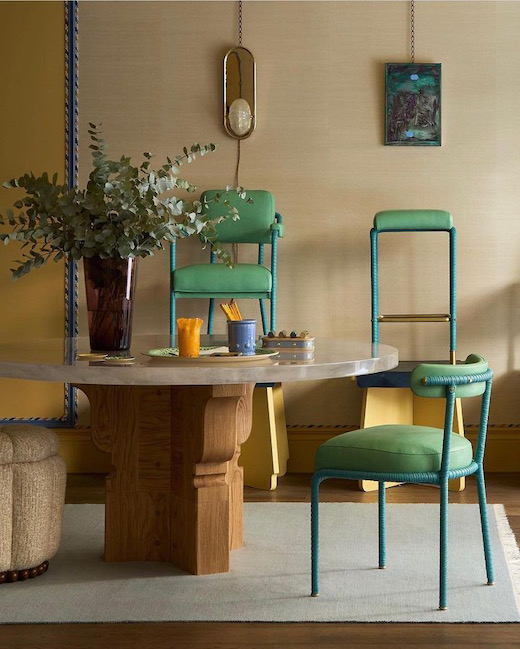The history of wallpaper
From Papyrus to palaces, here is a (brief) look-back at the history of wallpaper.
Have you ever looked at a beautifully adorned wall and wondered about the story behind it? Well, buckle up, because we’re about to take you on a whistle-stop tour through the fascinating history of wallpaper, where every pattern tells a tale! Any guesses where the earliest surviving fragment of European wallpaper was found?? In Christ’s College Cambridge, dating back from 1509!! It was made by Hugo Goes of York, and had a damask-style design of pomegranates.
FUN FACT…
Between 1712-1836, there was a tax in Britain, introduced under Queen Anne, on buying patterned and printed wallpaper. The tax could be bypassed by purchasing paper and having it stencilled.
ANCIENT BEGINNINGS
Believe it or not, the roots of wallpaper stretch back thousands of years to ancient civilisations like Egypt and China. In Egypt, they used papyrus to create decorative wall coverings, while in China, paper-making techniques paved the way for the earliest forms of paper-based wallpapers. Imagine walking through the halls of a Pharaoh’s palace, surrounded by walls adorned with intricate designs – talk about ancient chic! As the centuries rolled by, wallpaper made its way westward along the legendary Silk Route, a network of trade routes that connected the East and West. Along this ancient path, merchants and travellers exchanged goods, ideas, and yes, even wallpaper. From the bustling markets of China to the grand palaces of Europe, wallpaper became a prized commodity, coveted for its beauty and craftsmanship.
MEDIEVAL MARVELS
Fast-forward to medieval Europe, where wallpaper started to become a status symbol among the wealthy elite. Picture castles, palaces, and grand estates decked in hand-painted masterpieces, each one a testament to the owner’s wealth and taste. These early wallpapers were like works of art for your walls, showcasing everything from elaborate floral motifs to scenes straight out of a fairy-tale.
BLOCK PRINTING
Block printing, one of the earliest methods of printing on textiles and paper, has a rich history that spans centuries. While the exact origins of block printing are difficult to pinpoint, evidence suggests that it emerged in ancient civilisations such as China, India, and Egypt. Block printing was introduced to Europe during the Middle Ages, likely brought back by Crusaders returning from the East. By the 14th century, block printing had become established in Europe, particularly in regions such as Germany and Italy. It was during this time that block printing began to be used for printing on paper, leading to the production of early printed books and playing cards. While block printing eventually gave way to more advanced printing techniques such as movable type and lithography, it remains an important part of cultural heritage in many parts of the world. Today, block printing continues to be practiced by artisans and craftspeople, preserving centuries-old techniques and traditions. Its enduring legacy serves as a reminder of the power of creativity and innovation throughout history.
FLOCK PRINTING
This technique originated in Europe during the 17th century and gained popularity in the 18th century as a luxurious decorative embellishment for textiles and wallpaper.
CHINOISERIE
Chinoiserie wallpaper, with its exotic motifs and Oriental-inspired designs, has a rich and fascinating history that spans centuries. The term “chinoiserie” comes from the French word “chinois,” meaning Chinese, and refers to Western interpretations of Chinese artistic styles and motifs. It first gained popularity in Europe during the 17th century, particularly in countries like England, France, and the Netherlands. European traders and explorers returning from the Far East brought back exotic goods and artifacts, sparking a fascination with Chinese culture and aesthetics. It was typically produced using woodblock printing or later, hand-painted techniques. Skilled artisans meticulously crafted each design, often incorporating metallic inks and vibrant colours to enhance the richness and depth of the patterns. Today, chinoiserie wallpaper continues to captivate designers and homeowners alike, offering a timeless elegance and sense of exoticism to interiors. It is often used in traditional and eclectic design schemes, adding a touch of glamour and sophistication to both residential and commercial spaces. Brands like de Gournay, Phillip Jeffries, Gracie and Fromental are known for these styles and designs.
Read our article on how to decorate with chinoiserie wallpaper.
THE INDUSTRIAL REVOLUTION
The 18th and 19th Centuries saw wallpaper go mainstream, thanks to the wonders of the Industrial Revolution. With the invention of steam-powered printing presses and mass production techniques, wallpaper became more affordable and accessible to the masses. Suddenly, everyone could add a touch of elegance and style to their homes, no castle required! It was during this time that William Morris started making waves, with Morris & Co creating the botanic prints they remain known for to this day. Think birds, flowers, trees and fruits.
ARTISTIC REVOLUTIONS
As the world entered the 20th century, wallpaper continued to evolve, reflecting the artistic movements of the time. From the flowing lines of Art Nouveau to the simplicity of the Arts and Crafts movement, wallpaper became a canvas for creativity and expression. Artists like William Morris became household names, their designs adorning walls around the world.
LUXURY IN THE MODERN AGE
Which brings us to the present day, where wallpaper has once again found its place in the spotlight of luxury and sophistication. High-end wallpaper is no longer just for the elite—it’s a staple of super-prime residential properties, high-end hotels, and swanky restaurants. From hand-painted silk wallpapers to bespoke designs crafted by world-renowned artists, luxury wallpaper is the epitome of elegance and opulence. So, the next time you find yourself admiring the walls of a luxurious hotel or dining in a chic restaurant, take a moment to appreciate the artistry and history behind the wallpaper. After all, every pattern tells a story, and the history of wallpaper is a colourful tale indeed!
And what’s the perfect accomplice to beautiful, high-end wallpaper? A specialist wallpaper installer, of course. Step up, Wells Interiors!
FURTHER READING
The V&A Museum have written an incredible article on the history wallpaper, check it out here.





